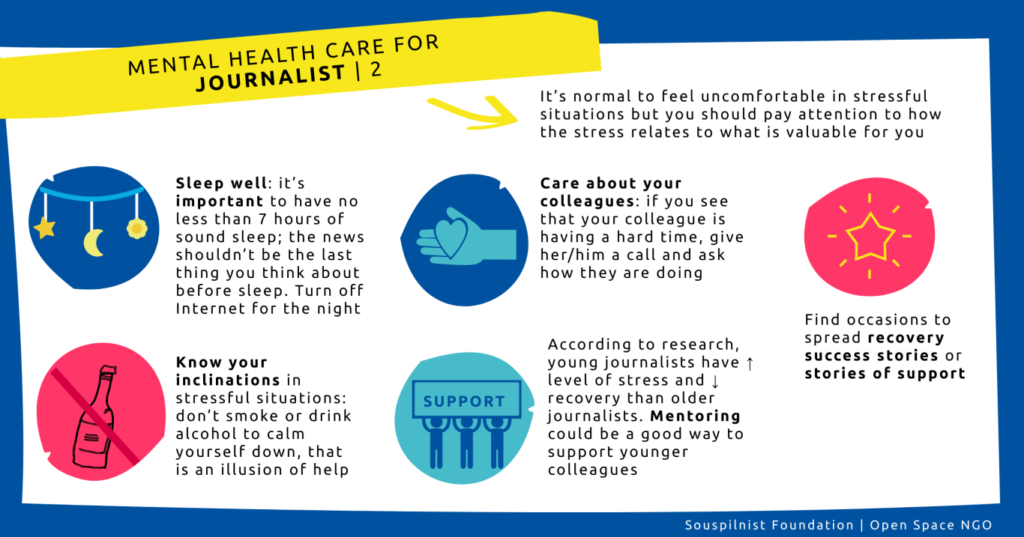Mental health problems are often perceived as taboo – something not worth talking about, especially at work.
However, every fourth person in the world experiences mental health problems. And since they affect all of us, we should feel able to talk about them, seek support or receive quality care. With more dialogue, we can refute more myths breaking down barriers, putting an end to isolation, shame, and inferiority, often felt by those facing mental health problems.
Caring about mental health in a media organization, creating a supportive environment for journalists, bolstering resistance to stress and learning how to take care of oneself and others not only helps the physical and emotional health and recovery of the team members, but also increases employees’ loyalty, productivity and engagement.
What is mental health? It is at the core of human health: a state of complete physical, mental and social well-being and not merely the absence of disease or infirmity. Mental health is a state of well-being in which an individual realizes his or her own abilities, can cope with the normal stresses of life, can work productively and is able to make a contribution to his or her community (World Health Organization).
Why is it important to develop a mental health care culture within a media organization?
According to research, three out of every five employees have experienced mental health issues because of work (Business in the Community (2017). Mental Health report: National employee mental well-being survey findings).
Multitasking, unstable and intense work schedules, being focused on emotionally complex subjects, attacks and harassment in connection with professional activities – these peculiar features of journalistic work can also cause significant stress, increase anxiety, result in emotional burnout, impair physical and mental health.
Research suggests that
– up to 80% of journalists have been exposed to a work-related traumatic event (The Dart Center for Journalism and Trauma);
– 31% reported having received threats during the year (Löfgren Nilsson & Örnebring, 2016, Sweden);
– 21,9 % of female journalists reported experiencing physical violence in relation to their work (Barton & Storm, 2016).
Journalism is often associated with work-related pressure, and stress is the biggest health and safety issues affecting workers in the media sector (National Union of Journalists, NUJ, UK).
It has been calculated that each case of stress–related ill health leads to an average of 30.9 working days lost (WHO, 2019, facts about mental health).
At the same time, there are effective practices for care of the employees experiencing mental health problems. It is possible to start with small, simple steps that everyone can take to take care of their own and their colleagues’ condition. Below are some tips to help reduce stress and help journalists take care of their mental health and emotional well-being.
Bolstering mental health at work comprises the following two components:
1) strengthening psychological resilience (recovery, the ability to cope with difficulties, and grow) at the personal level;
2) creating a supportive environment at work, and human-oriented processes.
Strengthening psyhological resilence
Interventions for stress and mental health management in the workplace can increase work productivity by 30% (National Institute for Health and Care Excellence, 2009).
Reporters, cameramen, designers and other newsroom staff can experience traumatic stress during news events, both while at the scene or at their desk. It is therefore important to provide systematic support to the media team regarding mental health issues to help oneself and colleagues in difficult times.
Team support can include:
- giving encouragement to undergo training on stress resilience, emotional regulation methods;
- giving encouragement to colleagues to discuss mental health issues. One option is to organize basic peer-to-peer support, where team members can call each other or the editor-in-chief, when seeking support. Sometimes it is enough to simply agree on this. Encourage communication between colleagues, especially when it comes to covering complex events. Reminding of the value and importance of each other’s work, the feeling of a helping hand from those nearby gives strength to cope with difficulties. When colleagues are working on a difficult story, let them know that they should not hide their stress, bury their feelings or emotions in these moments. Create an environment of trust in the newsroom, where there is awareness of the importance of acknowledging difficult feelings, and expressing them. Any mental health problem should not be viewed as something to be ashamed of or “uncomfortable” to talk about. Another option is to introduce mentoring practices. According to research, young journalists have higher levels of stress and a slower recovery than older journalists;
- building up the newsroom’s “network of contacts” to be used in emergencies. This contact list should contain a clear procedure for who to call during special or traumatic events. This procedure should be available to all employees;
- posting easy-to-understand and well-written procedures for taking care of oneself and colleagues, as well as basic methods of emotional regulation. For example, in the form of portable cards and / or posters on the walls in the newsroom.


Understanding when the newsroom needs expert help
Guide your employees toward monitoring burnout symptoms or mental health problems. The more people around you are aware of the first signs, the easier it will be to provide them with the help they need.
Below is a list of signs requiring expert attention:
- severing ties with your usual environment: if you avoid relatives and friends, lose the desire to communicate with others;
- changes in work behavior: for example, coming to work very early or staying late at work;
- obsessive thoughts and obsession with a certain subject;
- neglecting personal hygiene and appearance;
- difficulty concentrating, making decisions, maintaining conversation, memory impairment;
- feeling panic, constant anxiety;
- constant fatigue, poor self-management;
- prolonged depression, indifference and loss of interest in activities, including those that were previously enjoyed;
- self-blame and suffering constant guilt;
- sudden mood swings for no apparent reason;
- changes in eating habits, appetite, increased smoking or alcohol consumption.
Any of these signs indicate that you need a consultation and a checkup with a specialist. Especially if such manifestations last more than two weeks.
However, if you notice a change in the behavior or appearance of a fellow journalist, do not jump to conclusions about their mental health. If you feel ready, offer to have a conversation over coffee at a place outside of work, ask a lot of free-answer questions, being open-minded and non-judgmental. However, it is important to understand that this person may already be receiving help or not eager to share their experiences with you; this is also normal.
Сreating a supportive environment at work, and human-oriented processes.
Among the components of creating a supportive environment in the newsroom are:
- being aware of work-related risk factors, and controlling them;
- clearly defined principles of corporate communication, and following them;
- transparent internal processes and human-oriented services;
- culture of zero tolerance for stigma, specifically, being aware of the most common mental disorders and myths around this subject, adhering to the principles of correct interaction with colleagues experiencing mental health problems.
Mental health risk factors associated with journalistic activities:
- workload (both excessive and insufficient);
- lack of participation and control in the workplace:
- monotonous or unpleasant tasks;
- ambiguous role or conflict;
- lack of recognition at work;
- inequality;
- poor interpersonal relationships;
- poor working conditions;
- poor leadership / management and communication;
- conflict between domestic and work needs.
All of the above calls for attention from the newsroom’s top management.
Principles of corporate communication of journalists
Building psychological safety, trust and interpersonal relationships is the basis for the media team’s coordinated work. Measuring “temperature” will help better understand your colleagues, develop empathy, make humaneness, sincerity and trust the foundation of collaboration.
For example, a simple and effective tool for this is “check-in & check-out“.
Whenever possible, open and close your working days with team-friendly check-ins and check-outs, with each team member briefly answering questions about their condition and mood. This helps build a focus, increase self-awareness and clarify each member’s emotional state to build a proper collaboration.
Provide a place in the newsroom where your team can talk about what worries them.
Start holding newsroom meetings where your team can talk about:
1) your organization’s existing problems no one dares to bring up;
2) something that happened a while ago that your team still cannot get over.
A question-and-answer work mailbox for the team to be able to ask any questions during the week, with the top managers or owners, or investors responding during the week. This is an opportunity to ask a question that will be answered, without fear of looking incompetent. Develop a culture of “no stupid or awkward questions.”
Feedback sessions, developing a feedback culture
This widens the understanding of the team members’ actions and moods, allowing you to respond correctly to your colleagues’ positive and negative actions. Quality feedback can be built using the following algorithm:
1) observation (your description of the situation based on the particular facts);
2) influence (informing about the consequences of the person’s action, either positive or negative);
3) proposal (supporting, encouraging to move on at the same pace, or resolving an unpleasant situation).
Transparent internal processes and human-oriented services
Job assignments in the newsroom:
- set reasonable and agreed-on deadlines for implementation and completion of work;
- provide an appropriate working environment;
- define the job role and responsibilities as clearly and accurately as possible;
- where possible, engage employees in planning workload allocations.
Goals: Set goals and priorities within the organization and within the team so that everyone can focus on the important things. It is important to set SMART goals, jointly defined in the newsroom.
Work schedule: Set your work schedule and specific hours (start, end, lunch time) and mark them on the calendar for your your media team to know when you are there.
Know your natural clock and try to adjust the work rhythm accordingly. Choosing the best time to do a particular job depends on the nature of the job, with each particular case having a golden time of its own. And these individual characteristics should be taken into account by the team members and management and, if possible, when organizing the work process.
Recovery breaks: Make it a habit to get up and take a five minute walk after each hour of work. This enables better recovery and increases concentration. The most effective ways to relieve stress and improve mood in the course of a working day are short breaks for physical activity, as well as the so-called social breaks such as talking to colleagues about something unrelated to your work.
Make sure your employees have at least a half-hour lunch break, and encourage them to be away from the desk. It is best to combine lunch with a walk.
On a personal level, reward yourself for achievements. Most of the time, we tend to focus on what needs to be done next, forgetting to reward ourselves for what we have already done. Introduce acknowledgment practice into your newsroom. Employees in organizations with a culture of acknowledgment are more satisfied with their work and feel valued. Participate in and communicate within professional associations, such as independent media unions and the National Press Club, win professional journalism awards.
Human-oriented services in a media organization. Specifically:
- simplify the technological process of preparing materials as much as possible;
- use electronic services of editing and approving journalistic products at all levels of the organization;
- create a convenient record keeping and inventory and logistics system for your media team members’ work processes;
Organization design:
- make sure the workplace and environment are suitable for preparing editorial material. Noise, temperature and light levels can affect well-being. Where possible, consider space dividers and a quiet space to improve your work environment;
- make sure there are clear and regular communication channels with telecommuting employees, avoiding a situation where a person is expected to be online / in touch around the clock. Being constantly occupied with work contributes to rapid burnout. Employees should have time for self-reflection, for other activities and interests outside of work. This also applies to those team members who do not currently have a family, children, etc. Being free of the need to devote time to family does not mean having no interests other than work. Regardless of marital status, everyone should switch to different activities.
Remember that a journalist’s emotional and psychological state affects their assessment of the situation. However, it is important to be able to maintain internal balance and stay focused to do a high-quality journalistic job. At the same time, the way in which a journalist covers a story, interrogates sources and provides information may have different effects on those directly concerned by the event, and on the public in general. Therefore, the question of the importance of a journalist’s good mental health of goes beyond individual well-being, having a great social significance.



